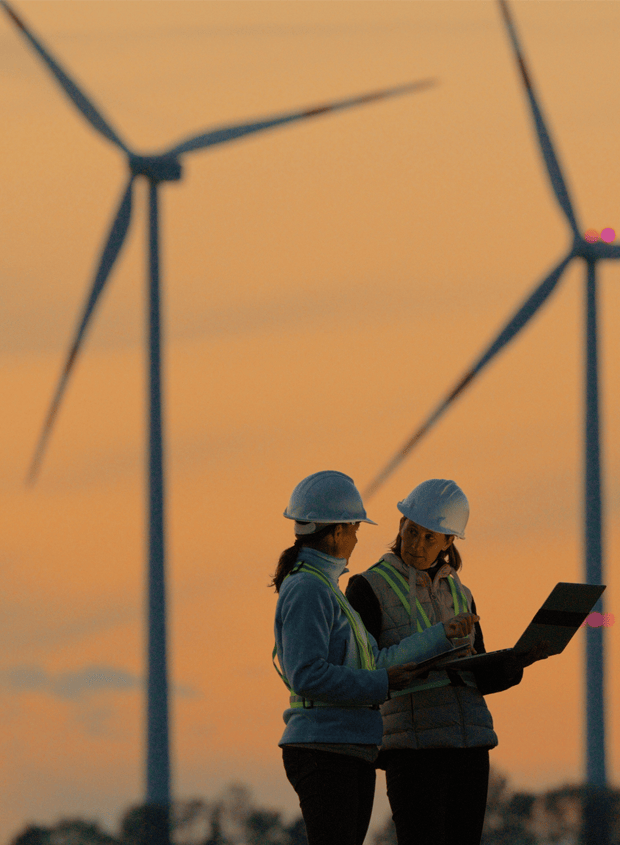Vestas Wind Systems is the world’s largest manufacturer of wind turbines. The company manufacturers both onshore and offshore wind turbines. The company also provides operation and maintenance services for wind power parks.
Topic: Biodiversity and nature loss
WHEB’s Objective: Limiting material negative social or environmental impacts
Company Objective: For Vestas to clarify its approach to biodiversity. Insights gathered during this engagement will inform longer-term behaviour change objectives.
Outcome: Reduced licensing delays; improved positioning as sustainability leader to attract new customers
Background: In early 2022, WHEB identified Vestas as having an elevated level of exposure to biodiversity impacts—both positive and negative—due to the nature of its operations and supply chain. Despite the clear interdependence between climate change and biodiversity, our initial attempts to engage the company on this issue were met with limited responsiveness. At the time, Vestas indicated that biodiversity was not a current priority, prompting concern that the company lacked a structured approach to managing these impacts.
We renewed our efforts via collaborative escalation in 2023, emphasising the importance of ensuring that the renewable energy transition avoids ecological harm and contributes positively to biodiversity via a collaborative escalation.
This prompted a more detailed response from the company in early 2023 with a detailed overview of current practices, including the use of bird and bat protection systems, environmental impact assessments, and the involvement of specialist consultants to develop a biodiversity strategy.
Activity: In the intervening time, like many corporates, Vestas has begun preparing to report in line with CSRD and published its double materiality assessment in 2024. Unfortunately, biodiversity was captured only under “impact materiality” but not “financial materiality”. We engaged with it to better understand how it had arrived at this conclusion and to encourage further action on biodiversity and nature loss.
Outcome
M1 Company acknowledges issue
Our March 2025 call with Vestas offered valuable insight into the company’s view on its biodiversity impacts. The company argued that its most material biodiversity impacts occur upstream in its supply chain, particularly through the mining of metals used in its turbines. These activities can lead to habitat destruction, pollution, and threats to biodiversity in ecologically sensitive regions. While Vestas does not operate the mines directly, it faces reputational and regulatory risks if sourcing is not managed responsibly.
Vestas does not currently consider biodiversity a financially material issue under double materiality assessment, though it does recognise its potential to become increasingly relevant to permitting processes and project development.
Vestas has explored frameworks such as SBTN and the TNFD LEAP approach, and has implemented location-specific assessments, particularly in upstream operations. However, it remains sceptical of standardised biodiversity assessment methodologies and hesitant to set biodiversity targets, citing challenges in measurement, materiality and uncertainty around impact.
Despite this caution, Vestas outlined active efforts to assess downstream impacts and highlighted various mitigation initiatives—such as minimising land clearance, protecting migration corridors, and restoring marine biodiversity in offshore wind projects.
Our next step is to write to the company reiterating the objectives we outlined during the call to:
- Encourage a clearer articulation—particularly in upcoming disclosures—of why biodiversity is not currently considered financially material.
- Explain how procurement and sourcing policies and practices are designed to mitigate upstream biodiversity risks.
- We will also suggest that greater transparency around how biodiversity considerations influence permitting and project development may prompt a future re-evaluation of biodiversity’s financial materiality as these factors gain prominence.
- Ask for case studies illustrating instances where standardised biodiversity data may be less applicable.
- Urge continued exploration of emerging biodiversity methodologies with the aim of setting credible, meaningful targets over time.
While Vestas’ current stance presents limitations, its openness to dialogue and ongoing assessment work is a positive step. We will continue monitoring progress and pushing for greater ambition in future engagements.
